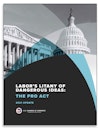
In the world of labor and employment policy, it is a well-known fact that organized labor has been hemorrhaging members for the past 65 years, and labor leaders have sought innumerable ways to reverse that trend. Since peaking at roughly 35% of the workforce in the 1950s, union membership has steadily declined. In 2018, it stood at just 10.5% of the workforce, with a mere 6.4% membership rate in the private sector.
To address this decline, the union movement has turned to its political allies hoping that a dramatic rewrite of the National Labor Relations Act (NLRA) and other statutes will help. Prior to the midterm elections in 2018, lawmakers introduced two pieces of legislation: the Workplace Democracy Act by Sen. Bernie Sanders (I-VT) and Rep. Mark Pocan (D-WI) and the Workers' Freedom to Negotiate Act by Sen. Patty Murray (D-WA) and Rep. Bobby Scott (D-VA). While these two bills differed in some ways, they were both legislative wish lists that contained numerous disturbing proposals, such as eliminating right to-work laws and redefining the concept of joint employment.
Following the 2018 elections, however, a new piece of legislation emerged. It included all the bad ideas from the previous bills under a single banner. This legislation is called the Protecting the Right to Organize (PRO) Act, ntroduced on May 2, 2019, by the new chair of the House Education and Labor Committee, Rep. Bobby Scott (D-VA), and Sen. Patty Murray (D-WA), ranking member of the Senate Committee on Health, Education, Labor, and Pensions. Despite its name, there is nothing positive about the bill.
With over 200 co-sponsors in the House and 40 in the Senate as of this writing, the PRO Act would dramatically change the NLRA in ways that would be harmful to workers, employers, and the economy. Like its predecessor bills, the PRO Act would obliterate many worker and employer protections that have been in the law for over 70 years. It would provide labor unions with numerous means to advance their organizing agenda, and it represents a significant threat to employers that must be taken seriously. That the president of the AFL-CIO, Richard Trumka, testified in person at the first House hearing on the PRO Act serves as a key indicator of how important this legislation is to labor leaders.
This paper highlights the major changes to the established framework of labor and employment relations that organized labor has in mind with the PRO Act. While it is unlikely to become law in the current Congress, the PRO Act is a harbinger of things to come if the political winds shift in 2020. When speaking of the dramatic changes to labor law proposed in 2017, Senate Minority Leader Chuck Schumer (D-NY) said, "We are going to fight, fight, fight to get this done. ... Should we ... get the majority, this will be at the top of our list[.]"5 If he is true to those words, the PRO Act could wreak havoc on American businesses and dwarf the nearly successful effort to enact card check in 2009.




